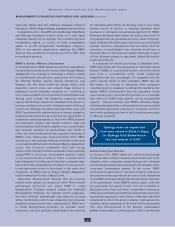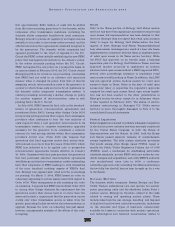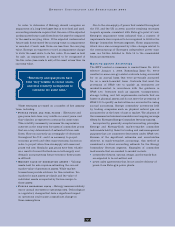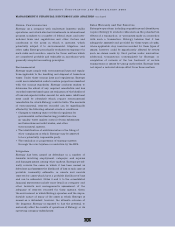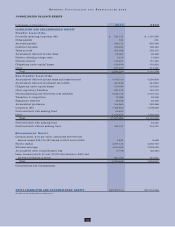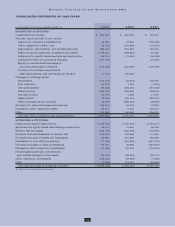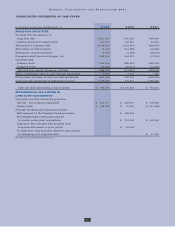Entergy 2003 Annual Report Download - page 47
Download and view the complete annual report
Please find page 47 of the 2003 Entergy annual report below. You can navigate through the pages in the report by either clicking on the pages listed below, or by using the keyword search tool below to find specific information within the annual report.
45
ENTERGY CORPORATION AND SUBSIDIARIES 2003
In order to determine if Entergy should recognize an
impairment of a long-lived asset that is to be held and used,
accounting standards require that the sum of the expected
undiscounted future cash flows from the asset be compared
to the asset’s carrying value. If the expected undiscounted
future cash flows exceed the carrying value, no impairment
is recorded; if such cash flows are less than the carrying
value, Entergy is required to record an impairment charge
to write the asset down to its fair value. If an asset is held
for sale, an impairment is required to be recognized if
the fair value (less costs to sell) of the asset is less than its
carrying value.
These estimates are based on a number of key assump-
tions, including:
FUTURE POWER AND FUEL PRICES - Electricity and
gas prices have been very volatile in recent years, and
this volatility is expected to continue for some time.
This volatility necessarily increases the imprecision
inherent in the long-term forecasts of commodity prices
that are a key determinant of estimated future cash
flows. There is currently an oversupply of electricity
throughout the U.S., and it is necessary to project
economic growth and other macroeconomic factors in
order to project when this oversupply will cease and
prices will rise. Similarly, gas prices have been volatile
as a result of recent fluctuations in both supply and
demand, and projecting future trends in these prices
is difficult.
MARKET VALUE OF GENERATION ASSETS - Valuing
assets held for sale requires estimating the current
market value of generation assets. While market
transactions provide evidence for this valuation, the
market for such assets is volatile and the value of
individual assets is impacted by factors unique to
those assets.
FUTURE OPERATING COSTS - Entergy assumes relatively
minor annual increases in operating costs. Technological
or regulatory changes that have a significant impact
on operations could cause a significant change in
these assumptions.
Due to the oversupply of power that existed throughout
the U.S. and the UK in 2002, and the resulting decreases
in spark spreads, consistent with Entergy’s point of view,
Entergy’s impairment tests indicated that a number of
impairments were required to be recognized in 2002 in the
Energy Commodity Services segment. These impairments,
which were also accompanied by other charges related to
the restructuring of Entergy’s independent power busi-
ness, are further detailed in Note 12 to the consolidated
financial statements.
MARK-TO-MARKET ACCOUNTING
The EITF reached a consensus to rescind Issue No. 98-10
effective January 1, 2003. Rescinding Issue No. 98-10
resulted in some energy-related contracts being accounted
for on an accrual basis that were previously accounted
for on a mark-to-market basis. Contracts that meet the
provisions of SFAS 133 to qualify as derivatives are
marked-to-market in accordance with the guidance in
SFAS 133. Contracts such as capacity, transportation,
storage, tolling, and full requirements contracts that are
based on physical assets and do not meet the provisions of
SFAS 133 to qualify as derivatives are accounted for using
accrual accounting. Energy commodity inventories held
by trading companies such as physical natural gas are
accounted for at the lower of cost or market. The adoption of
the consensus had minimal cumulative and ongoing earnings
effects for Entergy’s Energy Commodity Services business.
As required by generally accepted accounting principles,
Entergy and Entergy-Koch mark-to-market commodity
instruments held by them for trading and risk management
purposes that are considered derivatives under SFAS 133.
Because of the significant estimates and uncertainties
inherent in mark-to-market accounting, this method is
considered a critical accounting estimate for the Energy
Commodity Services segment. Examples of commodity
instruments that are marked to market include:
commodity futures, options, swaps, and forwards that
are expected to be net settled; and
power sales agreements that do not involve delivery of
power from Entergy’s power plants.
“Electricity and gas prices have
been very volatile in recent years,
and this volatility is expected to
continue for some time.”







